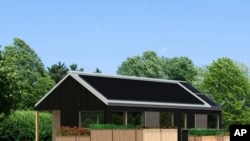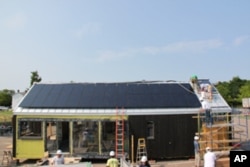For college students around the world, the race is on to design and build the most affordable, innovative and attractive solar-powered house.
Teams contending for the top prize will reconstruct their finished homes on the National Mall in Washington D.C., next month.
Among the hopeful entrants is a team from Middlebury College, a liberal arts school in the northeastern state of Vermont that is competing for the first time this year. Construction on the team's small house has been going on for months.
Middlebury college senior Addison Godine crouches to sand wooden trim around a doorway. While he works inside the house, a half-dozen other students are outside, unloading lumber, cutting siding and watering bushes that will line the deck.
"During the summer, I’m probably here about 10-12 hours a day,” Godine says. "It’s been a lot of work, but it’s finally paying off. The house looks as good as we could have hoped considering we’re the liberal arts team, the team of undergraduates against Cal Tech and all sorts of engineering schools like that. We’re the underdogs, but we think we’ll do okay.”
Competition in the biennial Solar Decathlon is fierce. The U.S. Department of Energy evaluates written proposals from dozens of schools and selects 20 teams to compete. Each team must design and build a 100 percent solar-powered house. This year, for the first time, houses will also be judged on affordability.
Team Germany won the competition two years ago. The Middlebury students traveled to Washington D.C., to tour the winning house as well as others on display on the National Mall.
“When we were at the Solar Decathlon in 2009, the students all agreed that what we want in our house would be more of a home for a family than a sort of eco-bachelor pad,” student Alex Jopek says.
So the Middlebury design adapts a traditional New England farmhouse to include two bedrooms, one bathroom and a large open family living space that encompasses a living room, study area, loft, kitchen and dining area.
Artist's rendering of interior of the team's solar-powered farmhouse (Middlebury College)
“People are immediately taken by the amount of light in the house. I think people also really like the kitchen,” says Melissa Segil.
She and teammate Jesse Catalano spent a lot of time on the design. Catalano points out the industrial-type shelves that turn what had been empty space in front of kitchen windows into a greenhouse.
“The idea is you’ll be able to start seedlings here - and then as I’m standing in this space, turn around, grab herbs, grab some lettuce - whatever - turn back this way where I have my cooktop, stove and sink and prepare what I’d like," Catalano says. "Very little movement, lots of thought.”
Middlebury students generated the ideas, but professional builders and contractors have helped with nearly every step. The Department of Energy gave each team $100,000 to work with. However, with construction, travel and other costs, they’ll expect to spend six times that. So fundraising and marketing have also been a big part of the project.
“What we’ve learned is that the solar decathlon is more like a marathon because it requires dedication at such a high level for such a long time,” Godine says.
Middlebury’s house is nearly finished, but the team faces one final challenge; they have to take it all apart, truck it to Washington D.C., and put it all back together again on the National Mall.
Sitting on the deck as a load of lumber is dropped off, Godine rolls his eyes at the thought. But then he looks at the house and smiles. At Middlebury, he says, students learn a lot about the world’s problems - especially environmental ones.
“And this competition is our opportunity to create a solution to these problems. Which is an amazing opportunity.”
The winner of the 2011 Solar Decathlon will be chosen October 1.














